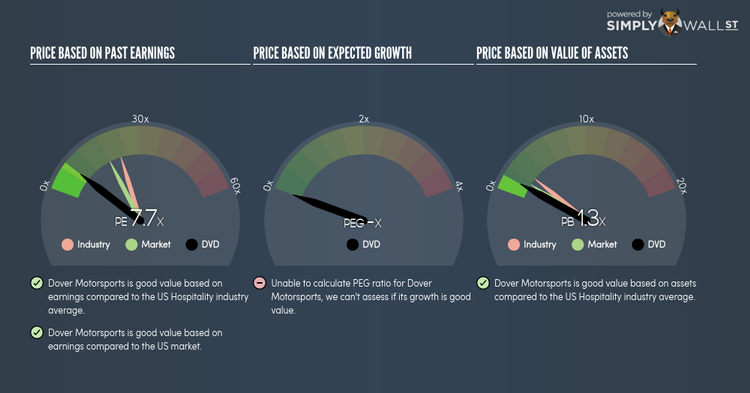Is Dover Motorsports Inc’s (NYSE:DVD) PE Ratio A Signal To Buy For Investors?

Dover Motorsports Inc (NYSE:DVD) trades with a trailing P/E of 7.7x, which is lower than the industry average of 22.7x. While this makes DVD appear like a great stock to buy, you might change your mind after I explain the assumptions behind the P/E ratio. In this article, I will deconstruct the P/E ratio and highlight what you need to be careful of when using the P/E ratio. Check out our latest analysis for Dover Motorsports
Demystifying the P/E ratio
P/E is a popular ratio used for relative valuation. It compares a stock’s price per share to the stock’s earnings per share. A more intuitive way of understanding the P/E ratio is to think of it as how much investors are paying for each dollar of the company’s earnings.
P/E Calculation for DVD
Price-Earnings Ratio = Price per share ÷ Earnings per share
DVD Price-Earnings Ratio = $2.05 ÷ $0.268 = 7.7x
On its own, the P/E ratio doesn’t tell you much; however, it becomes extremely useful when you compare it with other similar companies. We preferably want to compare the stock’s P/E ratio to the average of companies that have similar features to DVD, such as capital structure and profitability. A common peer group is companies that exist in the same industry, which is what I use. Since DVD’s P/E of 7.7x is lower than its industry peers (22.7x), it means that investors are paying less than they should for each dollar of DVD’s earnings. Therefore, according to this analysis, DVD is an under-priced stock.
Assumptions to be aware of
However, before you rush out to buy DVD, it is important to note that this conclusion is based on two key assumptions. The first is that our “similar companies” are actually similar to DVD, or else the difference in P/E might be a result of other factors. For example, if you compared higher growth firms with DVD, then its P/E would naturally be lower since investors would reward its peers’ higher growth with a higher price. The second assumption that must hold true is that the stocks we are comparing DVD to are fairly valued by the market. If this does not hold true, DVD’s lower P/E ratio may be because firms in our peer group are overvalued by the market.
What this means for you:
If your personal research into the stock confirms what the P/E ratio is telling you, it might be a good time to add more of DVD to your portfolio. But keep in mind that the usefulness of relative valuation depends on whether you are comfortable with making the assumptions I mentioned above. Remember that basing your investment decision off one metric alone is certainly not sufficient. There are many things I have not taken into account in this article and the PE ratio is very one-dimensional. If you have not done so already, I highly recommend you to complete your research by taking a look at the following:
Financial Health: Is DVD’s operations financially sustainable? Balance sheets can be hard to analyze, which is why we’ve done it for you. Check out our financial health checks here.
Past Track Record: Has DVD been consistently performing well irrespective of the ups and downs in the market? Go into more detail in the past performance analysis and take a look at the free visual representations of DVD’s historicals for more clarity.
Other High-Performing Stocks: Are there other stocks that provide better prospects with proven track records? Explore our free list of these great stocks here.
To help readers see pass the short term volatility of the financial market, we aim to bring you a long-term focused research analysis purely driven by fundamental data. Note that our analysis does not factor in the latest price sensitive company announcements.
The author is an independent contributor and at the time of publication had no position in the stocks mentioned.


